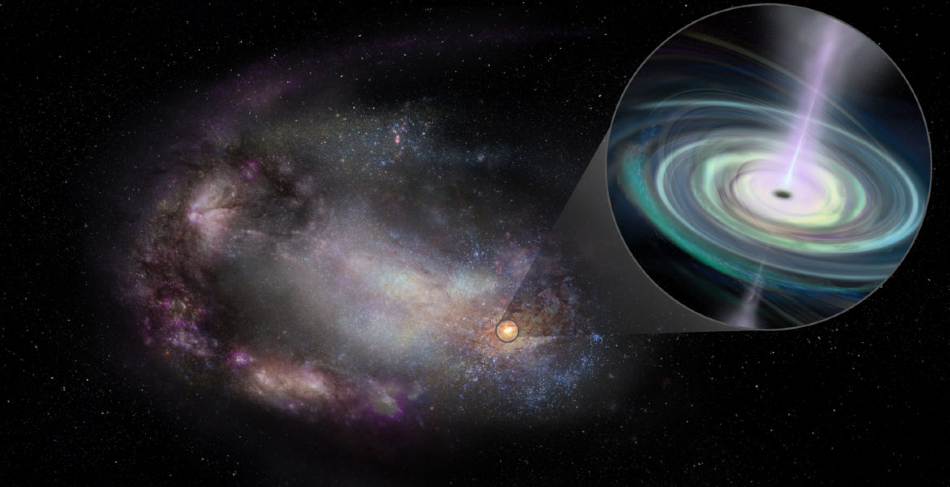Jan 6 2020
In the pursuit to gain deeper insight into the mechanism behind the formation of massive black holes in the early Universe, astronomers have obtained vital clues by discovering 13 such black holes in dwarf galaxies located within a billion light-years from Earth.
 Artist’s conception of a dwarf galaxy, its shape distorted, most likely by a past interaction with another galaxy, and a massive black hole in its outskirts (pullout). The black hole is drawing in material that forms a rotating disk and generates jets of material propelled outward. Image Credit: Sophia Dagnello, NRAO/AUI/NSF.
Artist’s conception of a dwarf galaxy, its shape distorted, most likely by a past interaction with another galaxy, and a massive black hole in its outskirts (pullout). The black hole is drawing in material that forms a rotating disk and generates jets of material propelled outward. Image Credit: Sophia Dagnello, NRAO/AUI/NSF.
These dwarf galaxies are over 100 times less massive when compared to the Milky Way. They are also among the smallest known galaxies to host massive black holes. The researchers predict that the mass of the black holes in such smaller galaxies is on average, nearly 400,000 times that of the Sun.
We hope that studying them and their galaxies will give us insights into how similar black holes in the early Universe formed and then grew, through galactic mergers over billions of years, producing the supermassive black holes we see in larger galaxies today, with masses of many millions or billions of times that of the Sun.
Amy Reines, Montana State University
Reines and her coworkers employed the Karl G. Jansky Very Large Array (VLA) of the National Science Foundation to discover the dwarf galaxies. The team will report the discovery at the American Astronomical Society’s meeting in Honolulu, Hawaii.
With the help of the VLA, in 2011, Reines and her colleagues discovered the first massive black hole in a dwarf starburst galaxy. For astronomers, the discovery was surprising and led to a radio search for more galaxies.
The researchers began by choosing a sample of galaxies from the NASA-Sloan Atlas, which is a catalog of galaxies discovered using visible-light telescopes. They selected galaxies containing stars with a total mass less than three billion times that of the Sun, almost equal to the Large Magellanic Cloud, a small companion of the Milky Way.
They also selected those candidates from the sample that were also included in the National Radio Astronomy Observatory’s Faint Images of the Radio Sky at Twenty centimeters (FIRST) survey, which was performed from 1993 to 2011.
Subsequently, with the help of the VLA, the team made new and more sensitive high-resolution images of 111 of the chosen galaxies.
The new VLA observations revealed that 13 of these galaxies have strong evidence for a massive black hole that is actively consuming surrounding material. We were very surprised to find that, in roughly half of those 13 galaxies, the black hole is not at the center of the galaxy, unlike the case in larger galaxies.
Amy Reines, Montana State University
According to the researchers, this shows that the galaxies possibly have combined with others earlier in history. This is in line with computer simulations that estimate that almost half of the massive black holes in dwarf galaxies will be observed to roam toward the edges of their galaxies.
This work has taught us that we must broaden our searches for massive black holes in dwarf galaxies beyond their centers to get a more complete understanding of the population and learn what mechanisms helped form the first massive black holes in the early Universe.
Amy Reines, Montana State University
Reines collaborated with James Condon, from the National Radio Astronomy Observatory; Jeremy Darling, from the University of Colorado, Boulder; and Jenny Greene, from Princeton University. The astronomers are reporting their findings in the Astrophysical Journal.